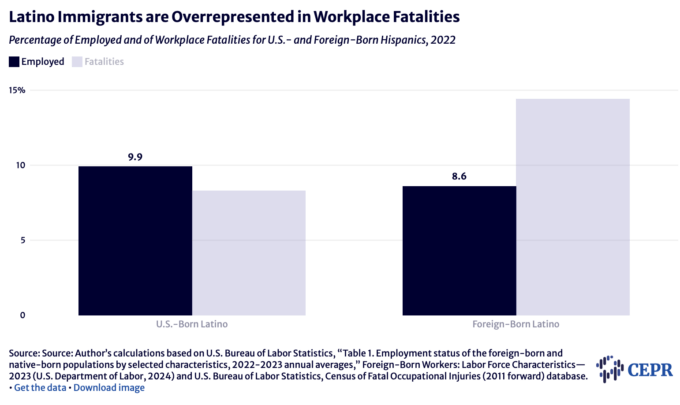AMERIKA
Latino Immigrants Do Many of the Most Dangerous Jobs
Latino workers typically have the highest rate of workplace fatalities among the major racial/ethnic groups (Figure 1). In 2022, they had a workplace fatal injury rate of 4.6 per 100,000. The Black rate was 4.2, the White rate was 3.5, and the Asian American rate was 1.7. Since 2018, there has been an upward trend in the number of fatal injuries for Latinos.
Figure 1

Looking a bit deeper, one sees that the high rate of Hispanic workplace injuries is driven by the very high rate among foreign-born Latinos. In 2022, 47 percent of employed Latino workers were foreign-born.1 And while they made up 8.6 percent of all employed people in 2022, they were 14.4 percent of workplace fatalities (Figure 2). U.S.-born Latinos were 9.9 percent of the employed, but only 8.3 percent of the workplace fatalities. Thus, Latino immigrants are overrepresented among the people who die at work.
Figure 2

Latino immigrants can be found at relatively high rates in construction and farming occupations. These are among the most dangerous occupations in the economy, and this is likely why Latino immigrants are overrepresented in workplace fatalities. Any death at work, of course, is terrible – and many of them are likely preventable. Advocates and policymakers should explore how stronger regulations and increased enforcement could reduce the mortality rate of Latino immigrants. The AFL-CIO has called for the Occupational Safety and Health Administration to increase its attention to the problems faced by Latino immigrant workers.
Notes
1. Author’s calculations based on U.S. Bureau of Labor Statistics, “Table 1. Employment status of the foreign-born and native-born populations by selected characteristics, 2022-2023 annual averages,” Foreign-Born Workers: Labor Force Characteristics—2023 (U.S. Department of Labor, 2024).
This first appeared on CEPR.
No comments:
Post a Comment